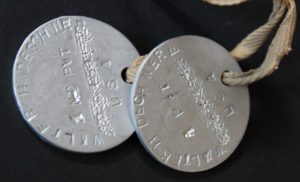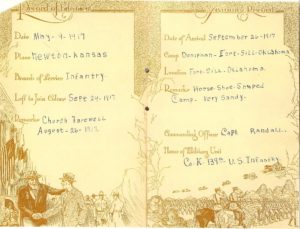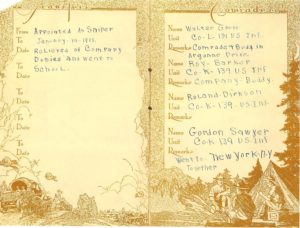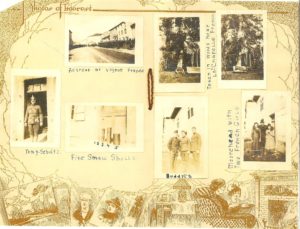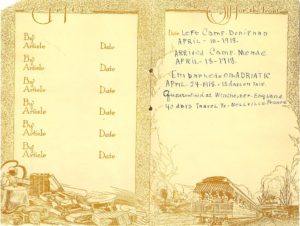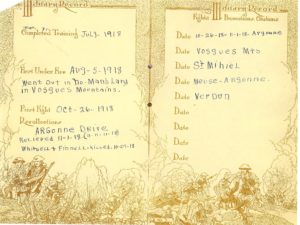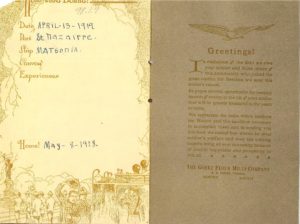by Kristine Schmucker, HCHM Curator
One of the smallest objects in the museum’s collection consists of two small aluminum discs on a cotton string. The object may be small, but tell a big story.
Not used officially in the U.S. until December 1906, the Identification Tag, or ‘dog-tag’ was a small aluminum disc worn around a soldier’s neck and included name rank and “USA.” Initially, only one disc was worn, but in July 1916, a second disc was added. The purpose of the tags were to aid in identifying the dead after battle.
These small discs are very personal objects that soldiers wore at all times – relaxing with friends or in the heat of battle. The Identification Tags might also be the last connection a family would have with their loved one.
We have several ‘dog-tags’ from Harvey County men who were in France during the Great War. Walter H. Deschner was one man.
Walter “Dash” H. Deschner was born January 9, 1895, the son of Charles and Orpha Fenter Deschner. He graduated from Newton High School May 21, 1916. Deschner was working as a clerk when he enlisted on May 9, 1917 and went to Doniphan, Fort Sill, OK where he was with Co K 139th U.S. Infantry.
Before he left, his mother, Orpha, wrote on the front fly leaf of his Bible; “mother’s prayers will be often and many for you.“
April 24, 1918 he left the US on the Adriatic and roughly 40 days later arrived at Mellville, France. August 5, was his “first under fire” experience in “No-Man’s Land in Vosgues Mountains.” On October 26 he was involved in the Argonne Drive.
Sad News
Evening Kansan Republican often reprinted “soldier mail” and in the October 21 issue the editor noted “there were many smiling faces that were soon overshadowed as word was noised about that three of the Newton boys . . . had fallen.“
Frank Sheets wrote that he had been involved in the “big battle which had been raging for five days, and seeing Roy Barker *** lying dead beside the road.”
Sheets went on to describe the conditions he experienced, noting “he was five days and nights without time to change his clothing and said that a cold rain fell much of the time.”
A Soldier’s Memories
These pages are from a Memory Book that Walter Deschner filled out highlighting his experiences while a part of the US Infantry.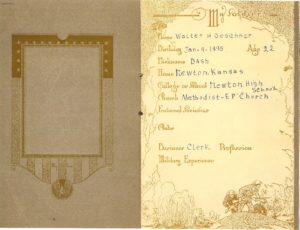
Activities
Friends and Places
On the Front
The same issue of the Evening Kansan Republican that had a letter from Sheets included one from Deschner. He wrote that “he was back from the front safe and sound. . . . Leo Burgener was injured, but not seriously, but Arthur Whitesell and Loren Finnell were both killed within 15 yards of him.” ***
Other battles he was involved in included Meuse-Argonne, and Verdun. He also noted the deathes of Whitesell and Finnell.
Return to Harvey County
Deschner returned home to Harvey County May 8, 1919 and resumed his work as a clerk for the Santa Fe Railroad. He worked for the Santa Fe for more than 25 years.
He married twice. On December 24, 1920, he married Erma Marie Ragsdale. Sadly, she died due to complications in child birth on March 23, 1939. The infant girl also died. He remarried March 5, 1945 to Emma Billau. Deschner died August 28, 1948 survived by wife, Emma, brother, George, and a niece.
Notes:
***The report of Roy Barker’s death turned out to be false, however both Arthur Whitesell and Loren Finnell were killed during the Meuse-Argonne drive. Both were from Harvey County.
Sources:
- Walter H. Deschner Collection, HCHM Archives 98.1
- “My Soldier” Scrapbook Walter H. Deschner Collection, HCHM Archives 98.1.9.
- The Jayhawker in France: the Unofficial Organ of the 137th Infantry Sampigny, France 5 February 1919, Vol. 1 No.2.
- “Pictorial Supplement Overseas Edition Camp Dodger” Published by 88th Division.
- Evening Kansan Republican: 25 July 1917, 9 August 1917, 17 July 1918, 24 September 1918, 21 October 1918, 26 October 1918, 20 September 1920, 24 October 1921, 23 March 1939, 28 August 1948, 1 September 1948.
- Greenwood Cemetery, “Deschner” at http://newton.harvey.ks.govern.com/cmquery.php?a=query&m=p&s2108479621=mlkflrefebslm1rt1iecken4v7
- “Identifying the Dead: a Short Study of the Identification Tags of 1914-1918” at http://www.westernfrontassociation.com/the-great-war/great-war-on-land/weapons-equipment-uniform/1033-identifying-dead-short-study-identification-tags-1914-1918.html#sthash.bl6XUO0P.dpbs

